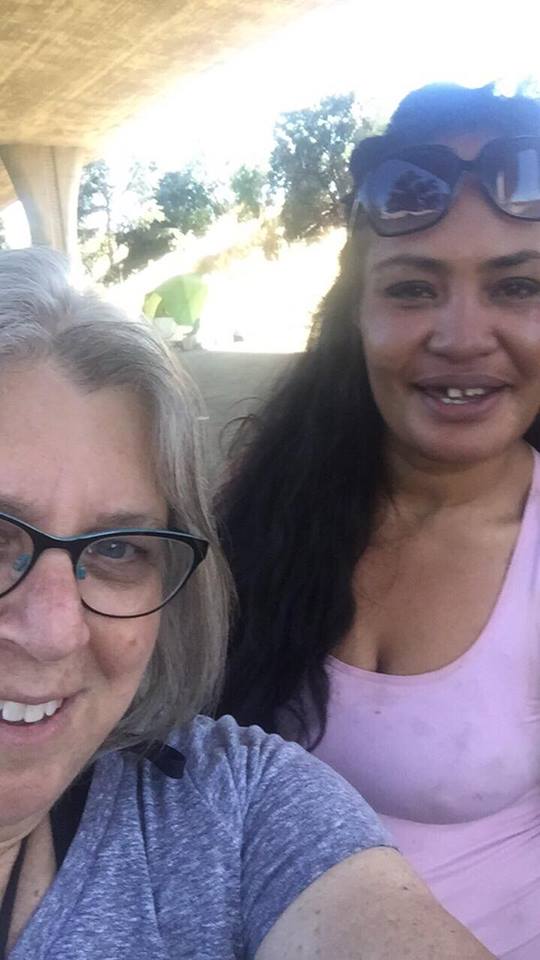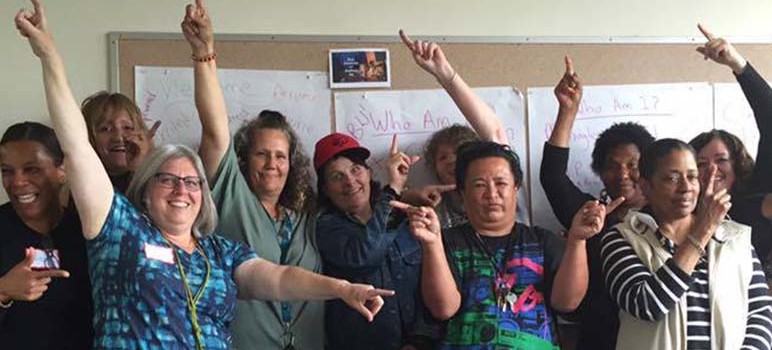I recently had lunch with one of the bravest and sweetest women I know. We reminisced, shared stories about mutual acquaintances and laughed a lot. After lunch, she gave me a tour of her new home. We agreed to meet again soon.
This would be just another recounting of girlfriends having a lunch date, but the difference is Annie lives outside. Her home is a dugout by a creek, and the acquaintance we talked about had just passed away while living on the streets.
I met Annie three years ago. I was a brand new intensive case manager working with clients who were unhoused, living in San Jose’s so-called Jungle encampment, or already newly housed. I had very little training, but lots of passion and a get-it-done attitude. Annie was living in the Jungle, before it was shut down, and getting ready to move into an affordable housing apartment with a permanent housing voucher.

Eileen and Annie (from left).
Both of us were overjoyed the day she moved into her apartment and excited about her new beginning. Shortly after moving in, Annie found out that she was pregnant. She was excited now that she had an apartment and could safely take care of a child. Unfortunately, for many people who have been homeless the hard work begins when they move inside—and Annie’s case was certainly a challenge.
Intensive case managers usually work with 20 or more clients at a time. Most of the clients have physical health problems, mental health issues, substance abuse histories, and lack financial knowledge, work skills and a support system. This is a time management nightmare for a case manager who needs to prioritize regular check-ins with all clients, solve the latest client crises, search for rental apartments in an impacted market and write timely documentation.
When case managers move on to new agencies and jobs, clients then must build a relationship with someone new. I lost my job at a time when Annie was depressed and needed continuity. Her baby had been born with a birth defect and died the day after his birth. She was struggling with this reality and the progress she had made over the year was not enough to prevent her eviction.
Those of us who work with people who are newly housed have found that retention or staying in their new home takes patience, support and constant negotiation with landlords and neighbors. Let me be clear: “Housing First” is a proven solution and intensive case management is a critical component of that success. Politicians, neighborhood and community leaders are grateful to have found a solution for this irksome problem of homelessness.
Since its inception in 2016, onRoute22 has helped more than 60 at-risk women find hope and dignity by providing empowerment workshops at locations in Santa Clara County. Our mission is to inspire and empower marginalized women through courage, compassion, and community. This month, we are partnering with the San Jose Peace and Justice Center, Recovery Café in San Jose, Santa Cruz Downtown Streets Team with the Santa Cruz Library, and the San Jose Public Library.
The onRoute22 model provides an antidote to the isolation experienced by someone who is newly housed. Defining personal goals with group accountability helps women who are homeless find resources and navigate their way through a complicated system of social services. The women in the group provide support through a crisis, maybe a ride to the doctor or a shoulder to cry on.
When one of our participants passed away, we shared the grief of losing her together. Johnette Villagomez, who was living in her car, died of heart failure on May 13, 2016. The transition from homeless to housed is difficult and we believe is buffered by this loving community of women in ways that a single individual case manager cannot duplicate.
Why is our name onRoute22? The VTA 22 bus travels from the East Side of San Jose, one of the poorest neighborhoods in Silicon Valley, and ends in Palo Alto, one of the richest cities in the country. The VTA 22 bus is symbolic of the income disparity that the exists in Santa Clara County. This bus route is known as “Hotel 22” by the people that ride it at night to sleep, stay safe and warm, but onRoute22 it also represents their journey towards a self-sustaining life.
Eileen Hunter, who co-founded onRoute22 with Kristy Duncan, worked in the tech sector but changed direction after meeting a homeless woman on the VTA 22 bus commuting to work at Stanford from San Jose. While working as an intensive case manager with homeless women from the Jungle or the formerly homeless women isolated in their new permanent housing, she realized that community and connection are essential to a woman's well-being. Hunter also founded the Women's Gathering Place, a safe-haven for women and onRoute22. For more information about how to volunteer or otherwise support the organization, go to www.onRoute22.org or email
in**@on*******.org
. Opinions are the author’s own and do not necessarily reflect those of San Jose Inside.


> Shortly after moving in, Annie found out that she was pregnant. She was excited now that she had an apartment and could safely take care of a child.
Eileen:
Do you have any theories on how this happened?
Was this a virgin birth, or what?
Was there an angel involved to announce the happy event?
There seems to be a lot of socially disfunctional and irresponsible behavior involved in your narrative which seems to have resulted in Annie’s plight.
Do you think there were people involved in Annie’s life who failed in their social duty to foster and develop Annie’s sense of personal responsibility?
We strive to help the women make choices today that can bring about a change in their future. We look at the past but not to criticize. If there were people involved in her life who failed her then you are agreeing with onRoute22 that it isn’t her fault and there is hope for a different life. I’m very grateful to be her friend and that she allowed me to share her story.
For the life of me, I am trying to see how Annie’s experience – presumably representative of that if other homeless women – is materially different from that of homeless men, pregnancy and childbirth notwithstanding. It seems to me that men who have been homeless, who struggle with addiction, mental illness, health problems and all the rest are just as much in need of ongoing support as women.
But, in today’s political climate, the needs of men – and especially white men – are subordinated below every other possible classification if human being. So much for equality if access and opportunity. So much for equal protection under the law.
I absolutely agree that men also need these types of services. In fact we did a long term program for the men and women at one of the local shelters. The workshops were separated by gender because the issues were very different and we wanted everyone to feel comfortable. We would be grateful if someone stepped up to do the same for men and would be willing to share what we learned while working with the men at Grace Baptist Church Shelter. We however are volunteer run and are focusing our program for women. Absolutely no discrimination intended.
Speaking of “homelessness” and “affordable housing”, here is a recently discovered supply of vacant affordable housing:
https://www.zerohedge.com/news/2018-01-28/one-baltimore-neighborhood-has-highest-vacancy-rate-america
“One Baltimore Neighborhood Has The Highest Vacancy Rate In America”
This seems to me to be a no brainer: homeless women on Route22 in Palo Alto, highest vacancy rate in America in Baltimore — BINGO!!
Let’s put on our thinking caps and use our big Neolithic brains: is it easier to move the “homeless” from Palo Alto to Baltimore, or to move the vacant housing from Baltimore to Palo Alto?
Take extra time if you need it, but your answers will go on your permanent record.
I don’t know why judgmental comments catch me off guard, but they do. Sjoutsidethebubble: I imagine her pregnancy happened the same way all the others do…you know, the cheerleader with a 4.0, the (almost) college grad, the mom with 5 other kids, the business woman who was *this close* to asking for a divorce….yeah, it happens. And for homeless women who are either shown affection, or taken advantage of, it happens often. No angel needed.
We don’t need to involve Baltimore in “our” troubles – they’ve got their own to deal with. We’ve passed taxes to address our housing situation: (you look it up – I’m fortunate to have a bed to make, warm water for a shower, and get in my car to drive to a job I love, so I don’t have time right now). We have plenty of vacant structures ourselves, right here in the Silicon Valley that can and ARE being turned into homes for the homeless. (Check current articles of homes remodeled for homeless Veterans in the San Jose area).
Onroute22 seems like a positive step in the right direction. If Sjoutsidethebubble comes up with other plans for tackling this part of life in the Bay Area, I’ll look forward to reading the articles written about them. In the meantime, I am going to look into volunteering with this organization. If possible, try to be part of the solution.
> If possible, try to be part of the solution.
Feeding the pigeons is NOT the “solution” to the problem of too many pigeons.
> I don’t know why judgmental comments catch me off guard, but they do.
And YES, I was being “judgmental”, just as YOU were being “judgmental”.
Your judgementalism about my judgements caught ME off guard.